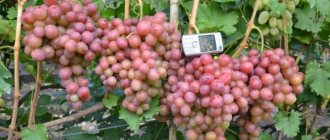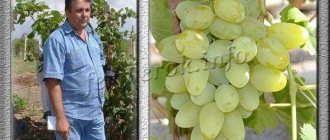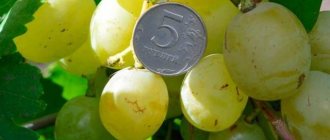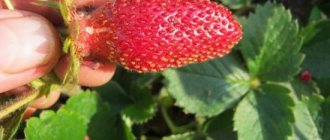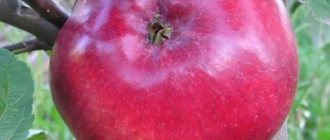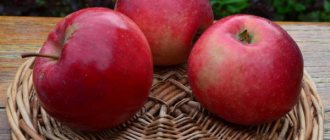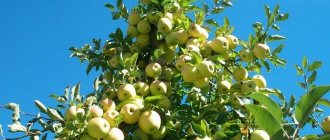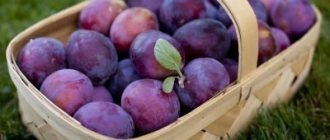Description of the variety Kolkhoznitsa
The melon variety Kolkhoznitsa was bred by breeders from the Biryuchekutsk station in the Rostov region. The application for registration was submitted in 1939, and the State Register approved it four years later as melon Kolkhoznitsa 749/753.
Characteristics
Main parameters of the melon variety Kolkhoznitsa:
- Fruit shape. Spherical, up to 20 cm in diameter.
- Pulp. White or yellowish, sweet, juicy, slightly crispy.
- Peel. Hard, but elastic, bright yellow or orange, sometimes with green. But always “mesh”.
- Weight. 0.7-1.4 (maximum 2) kg.
- Taste. Depends on the weather: the hotter and sunnier it is, the sweeter the fruits.
The growing season is short, so melon grows well even in the open ground of the Middle Zone, where summers are short and not hot.
pros
Advantages of melon variety Kolkhoznitsa:
- excellent taste;
- minimum calories;
- good transportability;
- resistance to cold;
- ideal volume: the fruit can be eaten immediately;
- short growing season.
The Kolkhoznitsa variety can be propagated by purchased or independently obtained seeds.
Minuses
Uncritical, insignificant compared to the advantages:
- weak immunity to diseases and pests;
- short shelf life;
- When grown in greenhouses, artificial pollination is required.
The disadvantages did not affect the popularity of the variety: Kolkhoznitsa has been grown by summer residents and merchants for almost 90 years.
When do melons ripen?
Already in mid-summer in July, there is a large selection of sweet and tasty melons on sale. But I would not recommend buying and eating these melons, ripened with the help of chemicals. It is best to ripen melons already in August and September; it is more likely that these melons ripened in the sun themselves, and not with the help of chemicals. After all, even for early varieties of melons, it takes a lot of time to reach a large size and ripen.
The time when a melon ripens depends on its variety (early ripening, mid-ripening, late ripening).
Raymond melons ripen 60 days after direct planting in the ground.
Kolkhoznitsa melons ripen approximately 75 - 95 days after germination.
“Torpedo” melons will ripen 85 - 95 days after germination.
You should buy melons no earlier than the end of July, preferably from the second ten days of August.
The ripeness of a melon can be determined by several signs:
1) The color of the peel should be uniformly yellow, there should be no greenish tint on it.
2) Pronounced sweet smell.
3) Dry ponytail.
4) When tapping the melon there should be a dull sound.
5) The peel is elastic; when pressed, it should easily return to its original position.
In our region, melon ripens at the end of August. You can determine the ripeness of a melon in the garden by its tail; it should be tough, the color of the melon should be deep yellow (with the exception of green varieties), and of course the melon has a fragrant smell.
It all depends on the region in which the melon grows, because weather conditions are decisive. The second factor is the type of melon (early or late).
I believe that you should not buy melons in stores before mid-July, before that time they are somehow “damp”, they don’t have that juicy and ripe taste that makes you want to eat them)). It is best to buy melons closer to autumn - the price becomes lower and they are definitely ripe and tasty.
As for the melons that we grow in our country houses and gardens, it also all depends on the variety and weather conditions, but in most areas this is the end of summer - beginning of September for late varieties of melons.
Chemical composition of vitamins
Kolkhoznitsa melon is not just a tasty, but also a healthy product. The benefits are created due to the variety of composition:
- vitamins – A, C, E, PP, B (1, 2, 3, 5, 6);
- trace elements - potassium, magnesium, zinc, copper, manganese and iodine;
- minerals - iron, calcium, sodium, fluorine, cobalt, sulfur and chlorine;
- other beneficial nutrients: starch, ash, mono- and disaccharides, fatty acids, fiber.
The most “massive”, but devoid of calories, nutrient of Kolkhoznitsa is water, more than 80% of it is in the pulp. The juicy pumpkin pulp easily quenches thirst, simultaneously supplying the body with useful nutrients without a significant influx of calories.
Further care
To prevent the planted melons from freezing, a temporary greenhouse is made for them or covered with a film, which is dismantled with the arrival of stable heat (most often in early July).
Further care of the crop consists of watering, fertilizing, pinching, as well as loosening the soil between the rows, which is carried out only until the leaves in the rows close.
Watering
Melon does not tolerate high air humidity and an abundance of water in the soil. Moderate watering is needed at the beginning of the growing season; watering is not necessary afterwards. Do not use cold water - this can cause illness.
Top dressing
Requires 3-4 feedings per season:
- nitrogen fertilizers 2 weeks after transplanting into the ground - this promotes active growth;
- After another 2 weeks, fertilizing is repeated;
- in the second half of July, pour in herbal infusion or mullein infusion;
- During fruit ripening, phosphorus fertilizers are applied.
In order for the melons to be juicy and sweet, it is important to properly apply nitrogen fertilizers. Part is applied during sowing, the other - in the phase of appearance of 4-5 true leaves.
Protection from diseases and pests
Root rot affects young shoots and sprouted seeds; prevention begins even before sowing. The seeds are treated with a light pink solution of potassium permanganate at a temperature of up to +25°C for half an hour, after which they are washed and dried.
Fusarium wilt affects melons at the beginning and middle of the season in open ground. Prevention against this dangerous disease is also carried out with a weakly concentrated solution of the drug “Trichodermin”. The first treatment is 2 weeks after planting in the ground, when the plants have taken root. If the plant is sick, treatment is carried out at the root according to the instructions for the drug.
Melons are often attacked by pests: aphids, spider mites, wireworms, cutworms. You can fight them with the help of bioinsecticides, which are sold in specialized stores and garden centers. The most effective drugs are “Actofit”, “Bikol”, “Bitoxibacillin”.
Compliance with cultivation technology
Typical mistakes of melon growers in the Moscow region:
- wrong choice of variety;
- method of planting directly into the ground, without seedlings;
- non-compliance with agricultural technology.
The technology for growing melon consists of timely sowing, proper care, proper formation of the bush, and disease prevention.
Bush formation
To get a good harvest, bushes are pinched.
The first time is at the seedling stage, removing all excess above the 4-5th leaf.
The melon forms the central trunk of the bush after planting in the ground. In order for the melon to bush, it is cut off after the fifth leaf, since it forms ovaries only on the side shoots.
It is recommended to leave one ovary on each lash, only 2-3 per bush. Then the plant will have enough strength to grow full-fledged large fruits.
During the formation of ovaries, non-fruiting canes are removed, and canes with ovaries are cut off above the 3rd leaf after the fruit. The cut areas are treated with a mixture of sulfur, coal and lime.
The formation of lashes continues until the melons begin to ripen, while the growth of lateral stems, flowering and fruit set occurs. The fewer fruits left to ripen, the larger they will grow.
Melon kolkhoznitsa calorie content
The calorie content of fresh Kolkhoznitsa fruits is low - 31-34 kcal per 100 grams. This is less than the Uzbek Torpedo, bananas, mangoes, and many other exotics.
The amount of calories is affected by the degree of ripeness of the fruit: the riper the pumpkin, the sweeter the pulp and the more calories.
Kolkhoznitsa is a variety with the lowest amount of calories among melon varieties.
However, dried or dried pulp has almost ten times more calories.
Characteristics of the nutritional value of the fruit (g per 100 g of pulp): proteins - 0.6, fats - 0.3, carbohydrates - 7.1.
Protecting melons from diseases and pests
The main enemy of the Collective Farmer is fungal diseases. Various insects may also appear. High humidity or large amounts of potassium cause fusarium. Root rot is also possible; if it occurs, the plants are destroyed.
The following remedies can be used against other diseases:
- powdery mildew – pesticides for prevention;
- Fungicides are used before flowering and at the beginning of ovary growth;
- against insects - insecticides, soap solution, tobacco dust.
Beneficial features
The beneficial properties of melons have been known for decades.
Overall Impact
Here are the benefits of melon of the Kolkhoznitsa variety:
- Fiber solves the problem of constipation and facilitates the digestion of heavy and fatty foods.
- The juicy pulp perfectly quenches thirst, at the same time washing the kidneys and urinary tract.
- Melon is distinguished by an abundance of enzymes that are beneficial for digestion.
- Carbohydrates improve brain function by promoting the production of serotonin. This hormone of happiness helps to get out of depression, overcome stress or fatigue.
- Removes waste, toxins and heavy metals. Thus, it neutralizes the effects of poisoning, simultaneously ridding the body of extra pounds.
- The pulp contains a lot of iron - this is an element useful for people prone to anemia.
Contraindications
Kolkhoznitsa is undoubtedly a useful product, but its consumption has limitations.
Stop factors for melon consumption:
- diabetes mellitus (pumpkins are relatively high in calories);
- gastrointestinal problems;
- gallstones or kidney stones;
- breast-feeding.
Melon should not be eaten simultaneously with milk, honey, alcohol or on an empty stomach.
Melon is contraindicated for children under one year of age: it can cause flatulence or digestive problems.
How to buy a good melon
The best place to choose fruit is at the market. As a rule, in large chain supermarkets you can find products of different quality: both very good and very bad. And owners of private retail outlets, especially representatives of the southern republics, choose the best goods for sale. You should not be tempted by the largest melons, because they may turn out to be tasteless, watery, or “pumped up” with pesticides. It is best to choose a strong, elastic fruit of medium size. The fruit should have a natural color. A too bright yellow color indicates that growth stimulants and other harmful chemicals were used in the process of growing the melon.
It is strictly forbidden to buy cut melons, even if they are covered with plastic wrap . Dangerous bacteria multiply rapidly on cut fruits . In addition, it is difficult to wash properly.
Any fruit must be thoroughly washed before eating. It is best to do this in a bath, because it is convenient to rinse the melon from different sides. Once cut, it should be stored only in the refrigerator, and no more than 2-3 days. It stores much worse than watermelon.
Collective farmer melon growing in open ground
Melon is a fastidious crop that is accustomed to the climate of the southern regions. But its cultivation is also possible for Central Russia. Let's look at how to grow the Kolkhoznitsa variety in open ground.
How to plant correctly
The collective farmer is planted in open ground, taking into account the climate: seedlings or seeds (warm regions), only seedlings (cool regions).
Melon requires special conditions:
- sunny, spacious, wind-protected areas are suitable;
- soil – loam or other light soil;
- swampiness is excluded, dry areas are needed;
Landing rules:
- In the fall, future planting sites are supplied with fertilizers, in the spring - with ash, humus, compost or urea.
- The soil is “loosened” with sand.
Planting of Kolkhoznitsa is possible when the air temperature remains stable at a minimum of +11°C.
- The seedlings are carefully removed from the cups in which they grew. Make sure that the roots are not damaged.
- The plant should be planted at the same depth.
- The distance between the holes is 80-90 cm. They are sprinkled with sand.
- For the first seven to eight days, the seedlings are covered with a common film or plastic container, each seedling.
- Water with warm water.
When the temperature drops below +5°C, the bushes are covered.
Watering and fertilizing
The melon of this variety loves warmth, excess moisture is unacceptable - it is a useful partner for the fungus, to which the Kolkhoznitsa variety has no immunity.
To prevent fungus from appearing on the plant, water the melon with warm water so that it does not get on the leaves and stems.
Irrigation features:
- Once the pumpkins have set, the soil should be consistently moist.
- Grown fruit bushes are watered weekly.
- Watering is stopped when there are 15-20 days left before the crop ripens.
Harvest and storage
Unlike watermelons, melons clearly signal that it is time to remove them from the bush. The skin turns yellow, the berries begin to exude a characteristic sweet aroma. The collective farmer can be ripened at home on the window, under the bed or in another place, as long as it is dry there. Cut the fruits with a “tail”, that is, leave a stalk 3–5 cm long.
Melons are stored hanging in a cool room, large quantities are collected in braids or garlands
Handle the melons carefully; do not throw them, drop them, or stack them on top of each other in several layers. Any damage to the crust: a dent, a bruise, a crack, will lead to rotting of the fruit. Completely whole melons can be stored in the basement until the New Year, hanging each one separately by its tail or in a net. Storage temperature: +1... +3 ⁰C, humidity - 70–80%.
Video: tasting of eight varieties of melons, including Kolkhoznitsa
The main purpose of Kolkhoznitsa, like all melons, is for table use, that is, for fresh consumption. However, if you have harvested a rich harvest, there is no storage space or there are a lot of damaged fruits, then treat the melons as you would with ordinary berries. From their slices you can make preserves, compotes, jams, jams, and candied fruits. Melon is pickled, dried, frozen.
Melon marmalade - a beautiful and tasty delicacy

